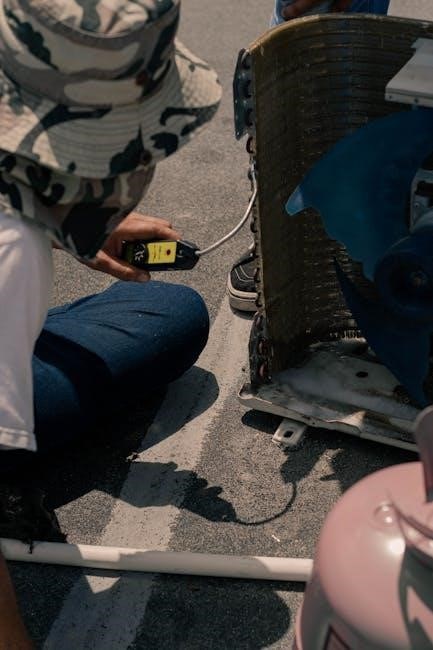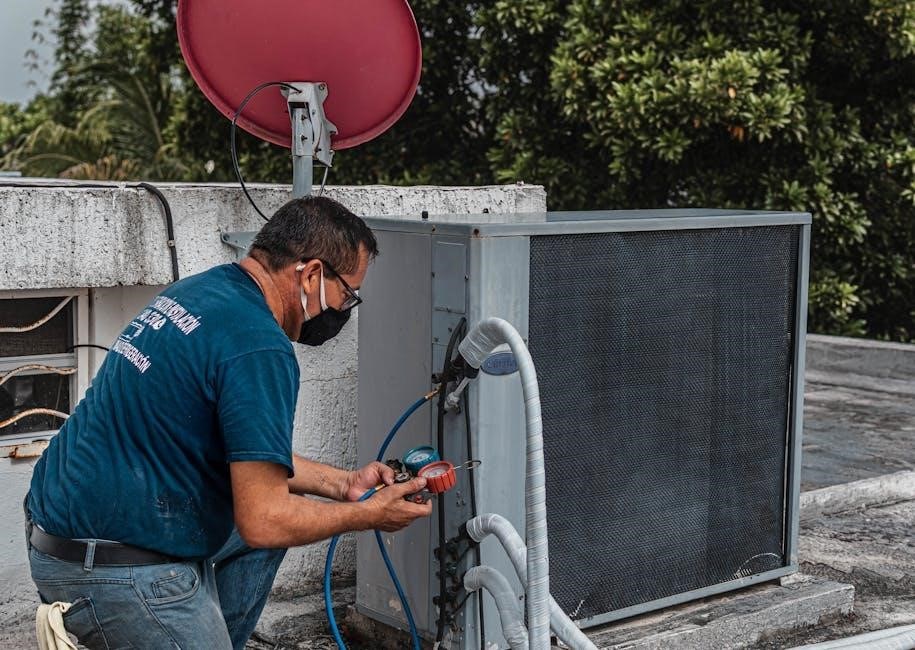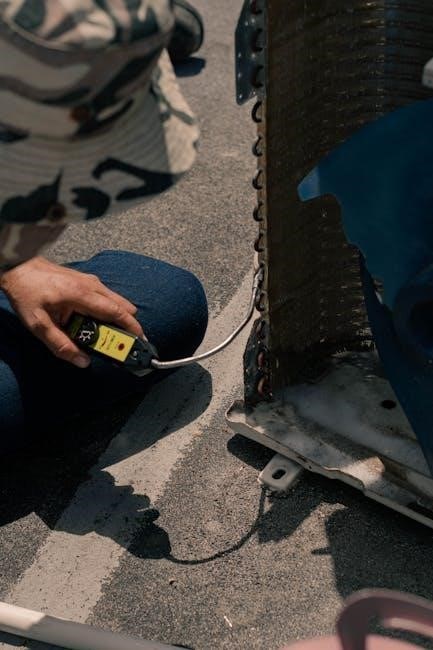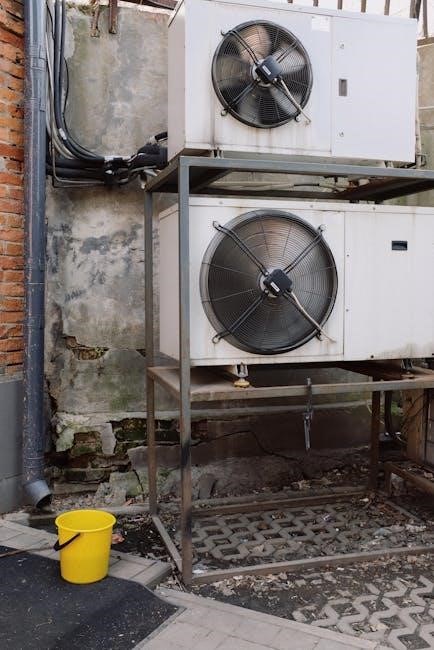
Air compressor troubleshooting is essential for maintaining efficiency and safety in industrial and residential applications. Common issues like low pressure, leaks, and motor overheating can disrupt operations. Regular maintenance and understanding system components are key to resolving problems effectively. This guide provides diagnostic steps and preventive practices to ensure optimal performance and longevity of air compressors.
1;1 Overview of Air Compressor Systems
An air compressor system is a mechanical device that converts power into potential energy stored in pressurized air. It consists of a compressor unit, a motor, an air storage tank, and control systems. The compressor draws in ambient air, compresses it, and stores it in the tank for use in various applications. These systems are essential in industries like manufacturing, construction, and automotive for powering tools, pneumatic systems, and processes. Air compressors come in different types, including reciprocating, rotary screw, and centrifugal designs, each suited for specific needs. Proper installation, regular maintenance, and adherence to safety standards are crucial for optimal performance and longevity. Understanding the system’s components and operation is the first step in effective troubleshooting and maintenance.

1.2 Importance of Regular Maintenance
Regular maintenance is critical for ensuring the optimal performance, safety, and longevity of air compressor systems. Neglecting maintenance can lead to reduced efficiency, increased energy consumption, and unexpected breakdowns, resulting in costly repairs and operational downtime. Routine checks help identify potential issues early, such as worn-out parts, leaks, or overheating, allowing for timely interventions. Proper maintenance also ensures compliance with safety standards, preventing hazards like explosions or equipment failure. By following a scheduled maintenance plan, users can extend the lifespan of their air compressors, reduce operational costs, and maintain consistent air quality. Regular maintenance is not just a preventive measure but a necessity for reliable and efficient operation in industrial and residential applications.

Common Issues in Air Compressors

Air compressors often face issues like low pressure, inconsistent airflow, leaks, and motor overheating. These problems can disrupt operations and lead to costly repairs if not addressed promptly.
2.1 Low Pressure or Inconsistent Air Flow
Low pressure or inconsistent air flow in air compressors can significantly reduce efficiency and performance. This issue often arises due to clogged air filters, which restrict airflow, or improper pressure settings. Additionally, a malfunctioning pressure regulator or a small tank capacity relative to demand can cause inconsistent flow. Leaks in hoses or connections may also contribute to low pressure. To address this, inspect and clean or replace air filters regularly. Check for leaks using soap solutions and tighten connections as needed. Ensure the pressure regulator is calibrated correctly and consider upgrading to a larger tank if demand exceeds current capacity. Regular maintenance and timely repairs are crucial to maintaining consistent airflow and optimal performance.

2.2 Leaks in the Compressor System
Leaks in the compressor system are a common issue that can lead to reduced efficiency and increased energy costs. These leaks often occur in hoses, connections, gaskets, or valves. To identify leaks, apply a soap solution to suspected areas; bubbles will form where air escapes. Turn off the compressor, inspect the system thoroughly, and tighten or replace faulty connections. Worn-out gaskets or seals should be replaced promptly. Regularly inspecting the system and addressing minor issues can prevent major breakdowns. Leaks not only waste energy but also strain the compressor, potentially leading to premature wear. Addressing leaks promptly ensures optimal performance, reduces operational costs, and extends the lifespan of the compressor. Always follow safety guidelines when performing repairs to avoid accidents.

2.3 Motor Overheating or Failure to Start
Motor overheating or failure to start is a critical issue in air compressors, often caused by blocked air vents, high ambient temperatures, or excessive workload. Overheating can damage the motor and reduce its lifespan. Check for blockages in vents or filters and ensure proper ventilation. If the motor fails to start, inspect the power supply, circuit breakers, or fuses for electrical issues. A faulty motor starter or control panel may also be the culprit. In some cases, low voltage or a malfunctioning capacitor can prevent the motor from starting. Always allow the motor to cool before restarting. Regular maintenance, such as cleaning vents and checking electrical connections, can prevent these issues. If problems persist, consult a professional to avoid further damage. Addressing these issues promptly ensures reliable operation and extends the motor’s service life.
Understanding Air Compressor Components
The compressor unit compresses air, while the storage tank holds it. Pressure gauges monitor levels, and valves control airflow, ensuring safe and efficient operation.

3.1 The Compressor Unit: Function and Design
The compressor unit is the heart of the air compressor system, responsible for converting electrical energy into compressed air; It operates by drawing in ambient air through an inlet valve, compressing it within a cylinder, and then discharging it into the storage tank. The design typically includes pistons, cylinders, and valves, which work together to achieve the compression process. Depending on the type, compressors can be reciprocating, rotary screw, or centrifugal, each with unique mechanisms suited for different applications. Proper lubrication and cooling are critical to prevent overheating and ensure longevity. Regular inspection of the compressor unit is essential to identify wear and tear, such as worn piston rings or damaged valves, which can lead to reduced efficiency or complete system failure if left unaddressed.

3.2 Air Storage Tank: Capacity and Safety
The air storage tank is a critical component of the air compressor system, serving as a reservoir for compressed air. Its capacity, measured in gallons, determines the system’s ability to meet demand during peak usage. The tank’s design typically consists of steel or fiberglass, with safety features like pressure relief valves to prevent over-pressurization; Proper sizing ensures efficient operation, while regular inspections are essential to identify rust, corrosion, or damage that could compromise safety. Maintaining the tank involves draining condensate to prevent moisture buildup, which can lead to internal corrosion. Adhering to safety standards and manufacturer guidelines is vital to avoid accidents and ensure reliable performance. A well-maintained storage tank not only enhances system efficiency but also contributes to the overall longevity of the air compressor setup.

3.3 Pressure Gauges and Valves: Roles and Calibration
Pressure gauges and valves are vital for monitoring and controlling air pressure in compressor systems. Gauges provide real-time pressure readings, ensuring the system operates within safe limits. Valves regulate air flow, enabling precise control over pressure levels. Proper calibration of gauges is essential for accurate measurements, while valves must be inspected for leaks or blockages. Miscalibrated gauges can lead to over-pressurization or insufficient pressure, causing system inefficiency or safety hazards. Regular maintenance involves checking valve seals and gauge accuracy. Replacing worn-out valve components and recalibrating gauges ensures reliable performance. Understanding their roles and maintaining them is crucial for optimal compressor functionality and safety. Always follow manufacturer guidelines for calibration and replacement to prevent operational disruptions and potential risks.

Diagnostic Steps for Troubleshooting
Effective troubleshooting involves systematic checks of compressor components. Start with visual inspections of hoses and connections to identify leaks or damage. Use pressure gauges to monitor airflow and detect irregularities. Analyze compressor oil and filters for contamination or wear, ensuring proper lubrication and filtration. These steps help pinpoint issues quickly, minimizing downtime and ensuring efficient operation. Regular diagnostics prevent minor problems from escalating into major repairs. Always refer to the manufacturer’s guidelines for specific troubleshooting procedures tailored to your compressor model. By following these steps, you can maintain optimal performance and extend the lifespan of your air compressor system. Consistent monitoring and timely interventions are key to reliable operation.
4.1 Visual Inspection of Hoses and Connections
Visual inspection is the first step in diagnosing air compressor issues. Examine hoses for signs of wear, cracks, or abrasions, which can lead to leaks or reduced airflow. Check connections for looseness, corrosion, or damage, as these can disrupt system performance. Use a flashlight and mirror to inspect hard-to-reach areas. Look for rust or mineral buildup in fittings and valves, which may indicate moisture issues. Ensure all couplers and plugs are securely attached to prevent disconnections during operation. If any damage is found, replace the affected parts immediately. Tighten loose connections and clean corroded areas to maintain airtight seals. Regular visual checks can help identify potential problems before they escalate, ensuring reliable operation and minimizing downtime. Always perform inspections with the compressor turned off for safety. This proactive approach helps maintain efficiency and extends equipment lifespan; Consistent visual monitoring is crucial for early detection of wear and tear. Regular inspections prevent minor issues from becoming major repairs. By addressing visible problems promptly, you can ensure optimal performance and safety. This step is foundational for effective troubleshooting and system maintenance. Always prioritize safety during inspections to avoid accidents. Regular visual checks are essential for maintaining air compressor health and reliability. Early detection of issues saves time and resources. This practice ensures your system operates efficiently and safely over time. Visual inspections are a simple yet critical step in air compressor troubleshooting. They provide immediate insights into system condition and help prevent unexpected failures. Always inspect hoses and connections thoroughly to maintain peak performance. This step is vital for identifying and addressing potential problems early. Regular visual inspections are a cornerstone of effective air compressor maintenance. They help ensure smooth operation and reduce the risk of costly repairs. Always make visual checks a routine part of your maintenance schedule. This practice is essential for maintaining the integrity and functionality of your air compressor system. By staying vigilant, you can address issues before they impact productivity. Visual inspections are a key diagnostic tool for ensuring the longevity and efficiency of your air compressor. Regular checks help maintain performance and safety standards. Always prioritize visual inspections as part of your troubleshooting routine. This simple step can prevent major issues and ensure reliable operation; Visual inspections are a fundamental aspect of air compressor maintenance and troubleshooting. They provide valuable insights into system health and help prevent unexpected downtime. Always conduct thorough visual checks to maintain optimal performance and safety. This practice is essential for extending the lifespan of your air compressor and ensuring its reliability. Regular visual inspections are a critical component of effective troubleshooting and maintenance. They help identify potential issues early, preventing costly repairs and downtime. Always inspect hoses and connections carefully to ensure your air compressor operates efficiently and safely. This step is crucial for maintaining system integrity and performance. Visual inspections are a simple yet effective way to monitor the condition of your air compressor. Regular checks help identify and address issues promptly, ensuring smooth operation. Always prioritize visual inspections as part of your maintenance routine. This practice is vital for maintaining the health and reliability of your air compressor system. By staying proactive, you can prevent minor problems from becoming major issues. Visual inspections are an essential part of air compressor troubleshooting and maintenance. They provide immediate feedback on system condition and help ensure optimal performance. Always conduct regular visual checks to maintain the integrity and functionality of your air compressor. This step is crucial for preventing unexpected failures and extending equipment lifespan. Visual inspections are a key component of effective air compressor maintenance. Regular checks help identify potential issues early, ensuring reliable operation and minimizing downtime. Always inspect hoses and connections thoroughly to maintain peak performance and safety. This practice is essential for the longevity and efficiency of your air compressor system. By prioritizing visual inspections, you can address problems before they escalate, ensuring smooth and safe operation. Visual inspections are a fundamental part of air compressor troubleshooting and maintenance. Regular checks help maintain system health, prevent issues, and ensure optimal performance. Always conduct thorough visual inspections to keep your air compressor running efficiently and safely. This step is vital for extending equipment lifespan and reducing the risk of costly repairs. Visual inspections are a simple yet critical step in air compressor maintenance. Regular checks help identify potential problems early, ensuring reliable operation and minimizing downtime. Always prioritize visual inspections to maintain the integrity and functionality of your air compressor system. This practice is essential for ensuring safety, efficiency, and longevity. By staying proactive, you can address issues before they impact productivity. Visual inspections are a key part of effective air compressor troubleshooting and maintenance. Regular checks help maintain performance, prevent issues, and ensure safety. Always conduct thorough visual inspections to keep your air compressor in optimal condition. This step is crucial for extending equipment lifespan and reducing repair costs. Visual inspections are a fundamental aspect of air compressor maintenance. Regular checks help identify potential problems early, ensuring smooth operation and minimizing downtime. Always prioritize visual inspections to maintain the health and reliability of your air compressor system. This practice is essential for ensuring efficiency, safety, and longevity. By staying vigilant, you can address issues before they escalate, ensuring optimal performance. Visual inspections are a critical component of air compressor troubleshooting and maintenance. Regular checks help maintain system integrity, prevent issues, and ensure reliable operation. Always conduct thorough visual inspections to keep your air compressor running efficiently and safely. This step is vital for extending equipment lifespan and reducing the risk of unexpected failures. Visual inspections are a simple yet effective way to monitor the condition of your air compressor. Regular checks help identify potential problems early, ensuring smooth operation and minimizing downtime. Always prioritize visual inspections as part of your maintenance routine. This practice is essential for maintaining the health and reliability of your air compressor system. By addressing issues promptly, you can ensure optimal performance and safety. Visual inspections are a key part of effective air compressor maintenance and troubleshooting. Regular checks help maintain system health, prevent issues, and ensure reliable operation. Always conduct thorough visual inspections to keep your air compressor in top condition. This step is crucial for extending equipment lifespan and reducing repair costs. Visual inspections are a fundamental aspect of air compressor maintenance. Regular checks help identify potential problems early, ensuring smooth operation and minimizing downtime. Always prioritize visual inspections to maintain the integrity and functionality of your air compressor system. This practice is essential for ensuring efficiency, safety, and longevity. By staying proactive, you can address issues before they impact productivity. Visual inspections are a critical step in air compressor troubleshooting and maintenance. Regular checks help maintain performance, prevent issues, and ensure safety. Always conduct thorough visual inspections to keep your air compressor running efficiently and safely. This step is vital for extending equipment lifespan and reducing the risk of costly repairs. Visual inspections are a simple yet effective way to monitor the condition of your air compressor. Regular checks help identify potential problems early, ensuring smooth operation and minimizing downtime. Always prioritize visual inspections as part of your maintenance routine. This practice is essential for maintaining the health and reliability of your air compressor system. By addressing issues promptly, you can ensure optimal performance and safety. Visual inspections are a key component of effective air compressor maintenance. Regular checks help maintain system integrity, prevent issues, and ensure reliable operation. Always conduct thorough visual inspections to keep your air compressor in optimal condition. This step is crucial for extending equipment lifespan and reducing repair costs. Visual inspections are a fundamental part of air compressor troubleshooting and maintenance. Regular checks help maintain system health, prevent issues, and ensure smooth operation. Always prioritize visual inspections to maintain the integrity and functionality of your air compressor system. This practice is essential for ensuring efficiency, safety, and longevity. By staying vigilant, you can address issues before they escalate, ensuring optimal performance. Visual inspections are a critical aspect of air compressor maintenance. Regular checks help identify potential problems early, ensuring reliable operation and minimizing downtime. Always conduct thorough visual inspections to keep your air compressor running efficiently and safely. This step is vital for extending equipment lifespan and reducing the risk of unexpected failures. Visual inspections are a simple yet effective way to monitor the condition of your air compressor. Regular checks help maintain performance, prevent issues, and ensure safety. Always prioritize visual inspections as part of your maintenance routine. This practice is essential for maintaining the health and reliability of your air compressor system. By addressing issues promptly, you can ensure optimal performance and safety. Visual inspections are a key part of effective air compressor troubleshooting and maintenance. Regular checks help maintain system integrity, prevent issues, and ensure reliable operation. Always conduct thorough visual inspections to keep your air compressor in top condition. This step is crucial for extending equipment lifespan and reducing repair costs. Visual inspections are a fundamental aspect of air compressor maintenance. Regular checks help identify potential problems early, ensuring smooth operation and minimizing downtime. Always prioritize visual inspections to maintain the integrity and functionality of your air compressor system. This practice is essential for ensuring efficiency, safety, and longevity. By staying proactive, you can address
Preventive Maintenance Practices
Regular maintenance ensures optimal air compressor performance. Schedule filter cleaning, oil changes, and drain inspections. Address minor issues promptly to prevent major repairs and extend equipment lifespan.